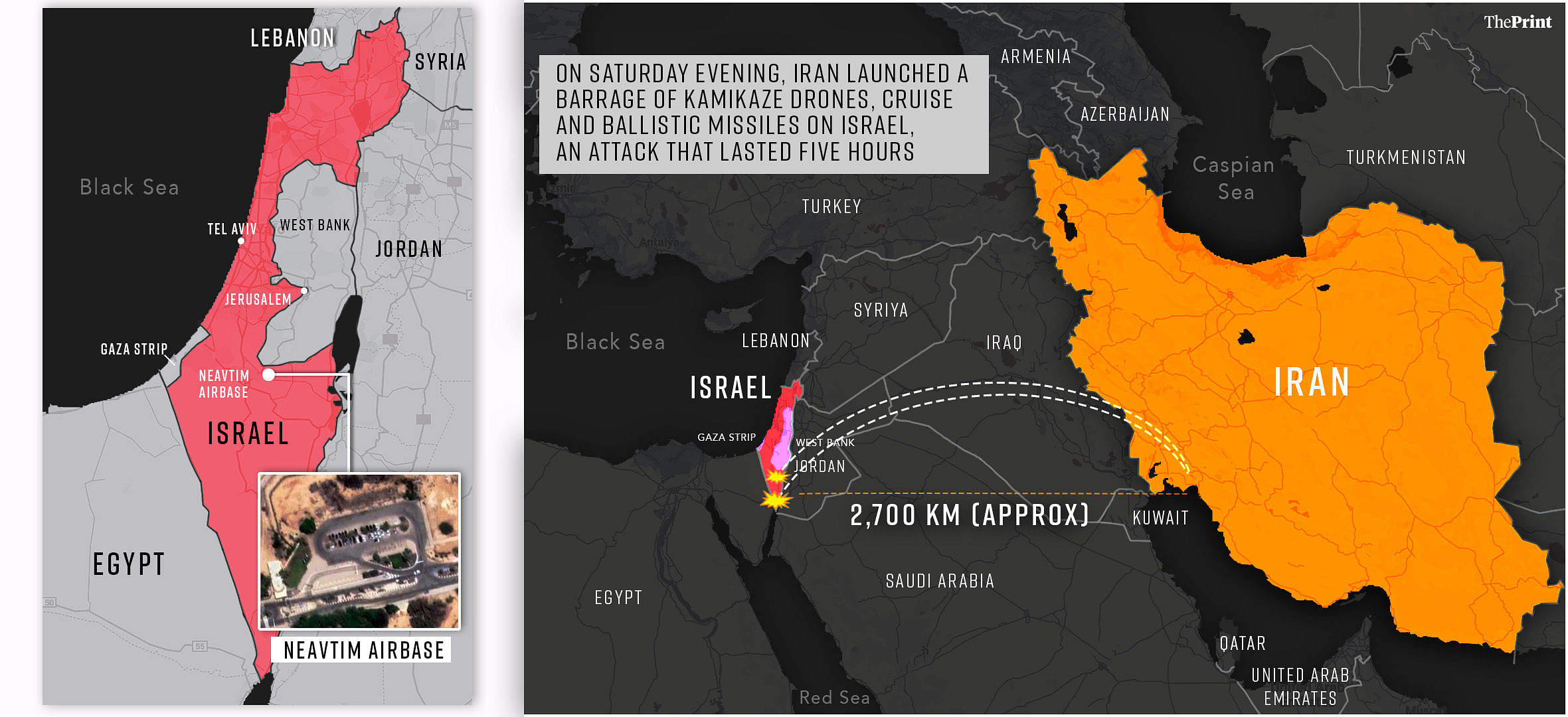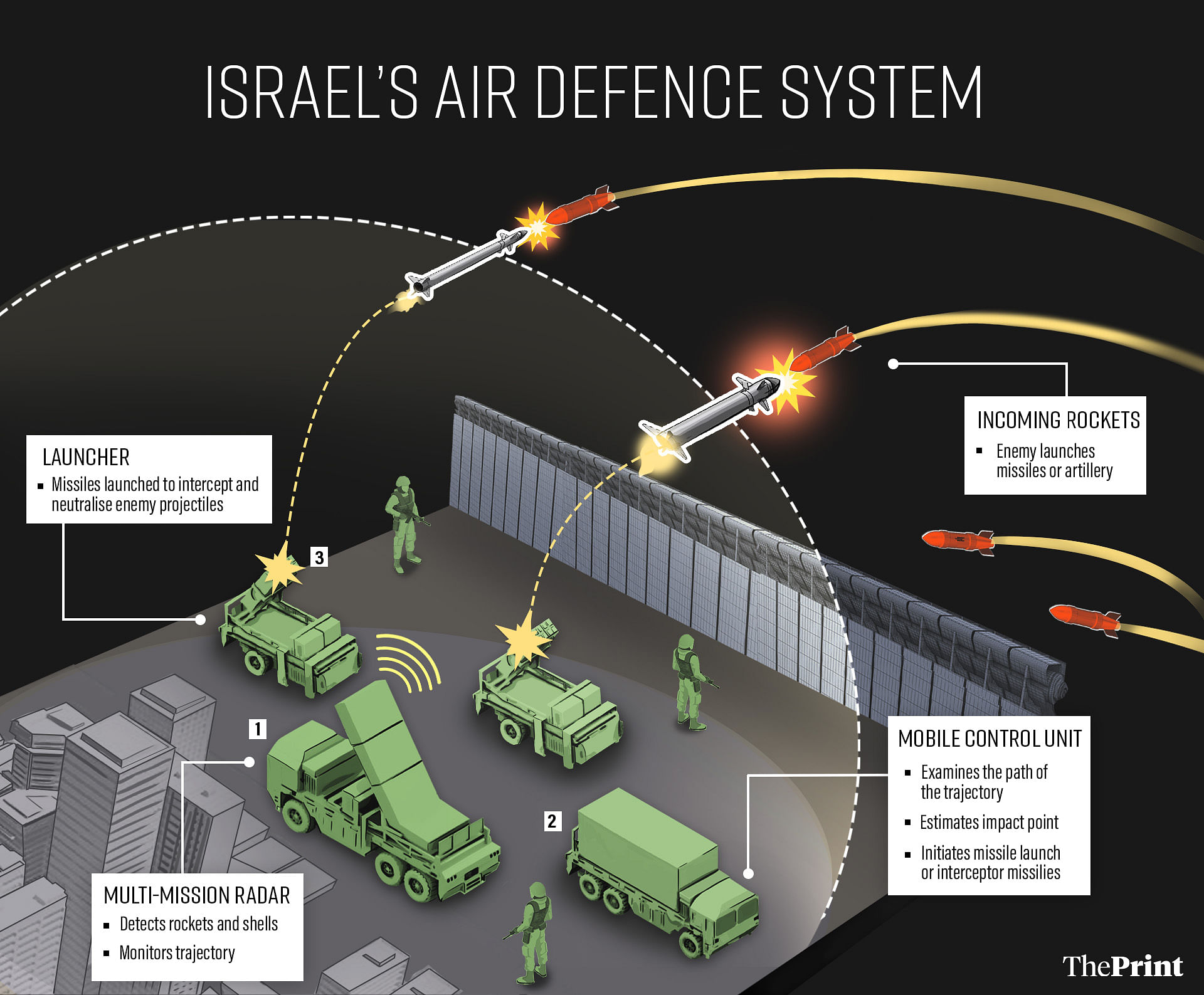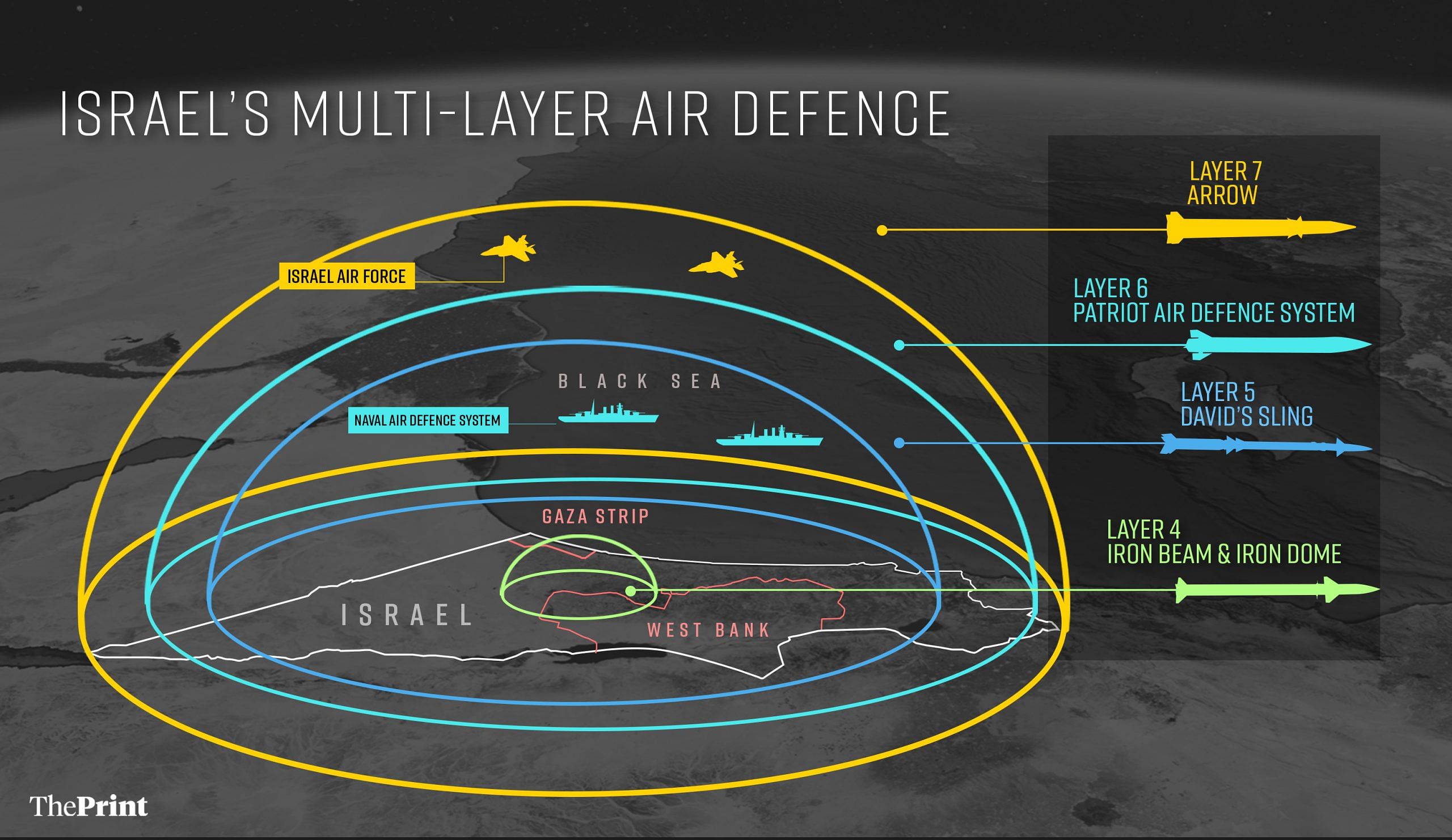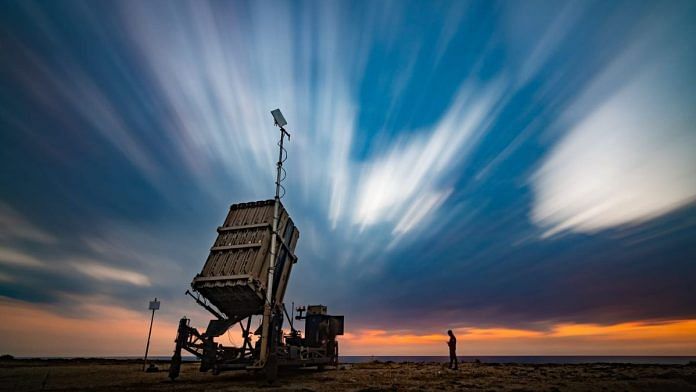New Delhi: On Saturday evening, Iran launched a barrage of kamikaze drones, cruise and ballistic missiles on Israel, an attack that lasted for five hours.
While such an onslaught of over 300 munitions would have been impossible to counter, the Israel military announced Sunday that “99 percent” of projectiles fired by Iran were intercepted by it and its partners, with only “a small number” of ballistic missiles reaching Israel. In total, around 170 drones, more than 30 cruise missiles and over 120 ballistic missiles were launched at Israel by Iran.
Countries like the US, the UK, Jordan and even Saudi Arabia helped in destroying several of the drones and some cruise missiles, but the bulk of the counter-offensive role was carried out by Israel’s multi-tiered air defence system.

Israel’s air defence is an eight-tier system that is integrated with one goal — to defend the country from attacks. India, too, has a similar multi-layered structure, but unlike Israel, which is spread over roughly 21,671 sq km, India’s total area is 32,87,263 sq km, from the snow-covered Himalayas to the tropical south. Moreover, unlike Israel, India’s critical defence and economic targets are spread out and there is no one system that can protect it all.
Also, India’s air defence system is primarily aimed at either protecting important cities as a whole or individual bases of the three services, which use a variety of systems for short- and medium-range defence.
The only operational long-distance air defence system that India operates is the S-400 Triumf bought from the Russians and that, too, aimed at countering attacks coming in either from Pakistan or China in the northern and eastern sector. The overall umbrella set-up that is being worked upon is the indigenous ballistic missile defence shield, which is currently in the second phase of development.
In contrast, Israel has an integrated air defence system. Israel’s Missile Defense Organization (IMDO) is a division within the Directorate of Defense Research and Development (DDR&D), at Israel’s Ministry of Defense which is responsible for the development, management and improvement of the country’s active defence systems. These include interceptors, launchers, radars, command and control systems, network connectivity and more.
On 6 May 1985, Israel and the United States signed a Memorandum of Understanding (MoU) on the development of a missile defence system against long-range threats. Many of IMDO’s programmes are carried out in close collaboration with the United States Missile Defense Agency (MDA) and receive joint funding.
Private defence industries from both sides also work together to create the full spectrum of air defence.
Also Read: Iran’s response to Israel’s attack is a turning point in history. Will Netanyahu fold?

MANPADS
The basic air defence system with the Israel Defense Forces (IDF) are the notorious Stinger man-portable air defence systems (MANPADS). The Stinger, fired from the shoulders, is a battlefield short-range weapon system mainly for low-level and slow-moving threats like helicopters.
The missile had earned its notoriety in Afghanistan, when it was used by the Taliban to fight the Russian occupation. However, the latest variants of the Stinger can also target higher and fast-flying fixed wing aircraft within about 15,000 feet in air, besides cruise missiles and low-flying drones.
Ukraine has successfully deployed the Stingers against Russian missiles and fighter jets, apart from drones.
SHORADS
Israel also operates the Machbet short-range air defence system (SHORADS). This is a gun-and-missile system on a self-propelled tracked vehicle, based on the M113 armoured personnel carrier. The missiles on the vehicles are Stingers and can be used against incoming cruise missiles and drones. These vehicles usually travel with the mechanised forces to provide battlefield defences.
Spyder
The Spyder family of Short/Extended/Medium/Long-Range Mobile Air Defence Systems (ADS) is used by Israel against a wide spectrum of threats, such as attack aircraft, helicopters, bombers, cruise missiles, UAVs and stand-off weapons.
Iron Dome
The star of the Israeli air defence system is the Iron Dome. This is a short-range system known for taking down largely unguided rockets fired from Palestinian territory. However, with upgrades, it can now take down cruise missiles, drones and more.
Operational since 2011, the system has, by and large, maintained a success rate of above 90 percent and has even touched 97 percent.
The Iron Dome does not take down every single rocket fired at Israel. Instead, it relies on a system of radar and artificial intelligence to determine whether an incoming rocket is a threat, and fires an interceptor only if the incoming rocket risks hitting a populated area or infrastructure. If there’s no such danger, the system ignores it and allows the rocket to land.
The Iron Dome missiles (Tamirs) are intended to self-destruct if they do not engage a target. They are developed to burst in close proximity to the incoming object rather than going for a direct hit.
David’s Sling
Sitting right in the centre of Israel’s air defence shield is David’s Sling. It is designed for taking down short-range ballistic missiles (SRBMs), aircraft, drones, and cruise missiles.
Each David’s Sling system has a vertical launcher containing up to 12 Stunner interceptor missiles, and unlike the Tamirs, comes with next-generation seekers, which allow the missile to slam into the target.
The manoeuvrable, two-stage, hit-to-kill Stunner missile has no warhead. The interceptor destroys threats with sheer force of impact.
American company Raytheon, which developed it with Israel’s Rafael, said that the Stunner missile is proved to defeat all short-range ballistic missiles — 92 percent of the worldwide theatre ballistic missile threat inventory.
The primary source of targeting data for David’s Sling is the Elta EL/M-2084 3D active electronically scanned array (AESA) radar.
Also Read: Hardened shelters, radars, defence systems & more — IAF quietly upgrades bases focused on China
Patriot air defence system
One grade above the David’s Sling is the American Patriot PAC-2 air defence system. While it has been developed as a counter to ballistic missiles, it can, of course, take on other aerial threats.

Arrow
The last, and most lethal, in Israel’s air defence tier is the Arrow, which is intended to take down long-range ballistic missiles.
There are two variants — Arrow 2 and Arrow 3. The Arrow 3 was first tested in combat last year after it intercepted a missile fired by the Iranian-supported Houthis in Yemen towards the Israeli city of Eilat. Unlike Arrow 2, it does not have a warhead and relies on a direct hit outside Earth’s atmosphere (exo-atmospheric).
Besides that, the other difference between the David’s Sling and the Patriot is that Arrow 3 targets the enemy missile in mid-course flight, and not the terminal stage, when the missile is already in Earth’s atmosphere and hurling down.
Israel uses both the variants of the missile.
Iron Beam
The Iron Beam is a new directed energy air defence system that is still being tested by Israel. This will not replace the Iron Dome, but will complement it.
The 100-kilowatt Iron Beam is designed to neutralise rockets, artillery and mortars (RAM), besides unmanned aerial systems (UAS), counter-unmanned aerial systems (C-UAS) and anti-tank missiles. It can function by itself or be integrated with other, broader defence systems. It uses a fibre laser to generate a laser beam to destroy an airborne target.
Each battery of the Iron Beam will consist of an air defence radar, a command and control (C2) unit, and two High Energy Laser (HEL) systems.
Naval air defence system
While a naval air defence system is used usually to defend one’s own assets, given the location and size of Israel, it is also used as an alternative counter-measure for missiles travelling over the sea.
Installed on board an Israeli Navy Sa’ar-class corvette is the C-Dome, the naval version of the Iron Dome. It had successfully intercepted a drone over the Red Sea earlier this month.
These corvettes are armed with two C-Dome systems, each having 20 Tamirs besides Barak-8 surface-to-air missiles, which are launched from 32 vertical launch cells.
While Barak-8 is long range, C-Dome is designed to intercept and destroy lower-flying aircraft, anti-ship missiles, as well as short-range rockets and drones.
Israel Air Force
Fighter aircraft and attack helicopters are another less talked-about air defence capability of the Israeli Air Force, along with the surveillance and command-and-control assets operated by it. The Israeli fighter jet fleet of F-15, F-16, and F-35 fighters have the capability to intercept and destroy cruise missiles and drones.
Israel had in 2021 shot down at least two Iranian drones that, it says, were heading toward Israeli territory.
This was the first time that F-35s operated by any nation were confirmed to have destroyed airborne threats, which showed how Israel has expanded the use of these fighters.
(Edited by Mannat Chugh)
Also Read: India receives fresh batch of Igla-S air defence system from Russia, to be deployed at LAC



